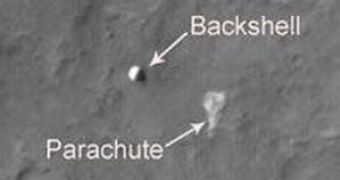It's like finding a needle in a haystack what NASA's Mars Reconnaissance Orbiter (MRO) has done. It has spotted about a dozen US landing spacecraft on the Martian surface and, incredibly, taken pictures of such accuracy that scientists have been able to identify individual rocks that were first photographed by the Viking landers in 1976.
The Spirit rover, which landed in 2004, as well as both Viking landers can be seen in the new images. The pictures show both of the Viking landers as well as their nearby heat shields and backshells. These are the top and bottom covers of the capsules in which the rovers descended through the Martian atmosphere.
From Spirit rover, the pyramid-shaped structure in which it landed was found, together with its backshell and parachute. "We know these sites well at ground level through the eyes of the cameras on Spirit and the Viking landers," said Dr Alfred McEwen from the University of Arizona, the principal investigator for the High Resolution Imaging Science Experiment (Hi-Rise) camera on MRO.
The satellite probe had already found the rover Opportunity and its landing structure, sending back images within its first week of operations in October 2006. It seems that Viking 1 is about 6 km (3.8 miles) away from the spot identified as the landing site during the Viking mission. The back shell of Viking Lander 1 was found about 260m (850ft) away and the heat shield at nearly four times that distance.
Viking 1 transmitted the first view from the surface of Mars and kept operating for more than six years after its touch down on July 20, 1976. "The biggest surprise is that you can still see what appears to be the parachute [of a Viking lander] after 30 years," said Dr Tim Parker, of Nasa's Jet Propulsion Laboratory in California.
Parker carefully matched rocks and other topographic features seen in the orbital views with those seen images the landers took on the ground. "I found a much better location match than had been made from earlier orbital pictures," he says. "Even individual boulders, just a metre across, seen by the Viking landers can be identified in the new images," Parker says.
Such observations could help scientists determine the rate at which dust accumulates on the surface. The MRO images help future Mars landings avoid potentially dangerous rocky outcrops. The Phoenix mission, scheduled for 2007, will be the first to benefit from this information, being able to make a much better assessment of which regions will be safe enough to land on. "This calibration will in turn allow the team to interpret images from other regions on Mars more accurately," said Alfred McEwen, leader of the HiRISE camera team.
Earlier MRO images pointed to the fact that the landing site originally picked for Phoenix was too dangerous. The new MRO images show that the area where Viking 2 landed is so rocky that "they wouldn't let us land there now" said McEwen. The new Spirit's images are already being used for planning that rover's next actions.
Photo credit: NASA

 14 DAY TRIAL //
14 DAY TRIAL //